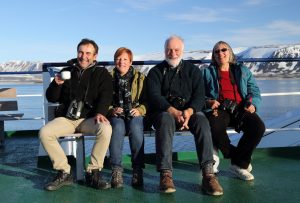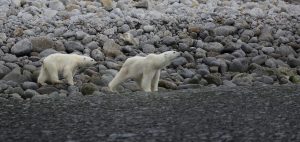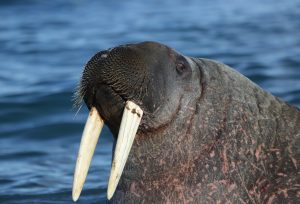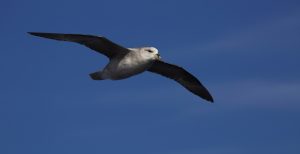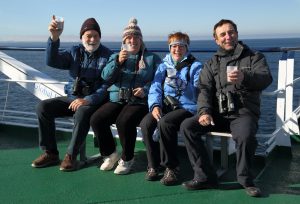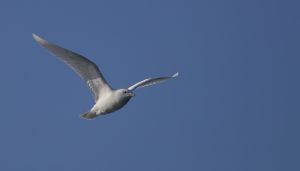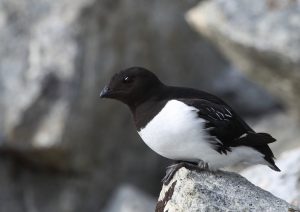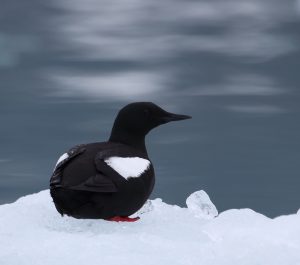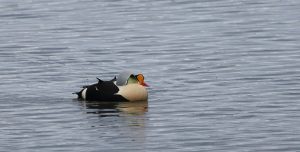Flying into Spitsbergen, holes in the cloud below reveal a stark bare-boned landscape of peaks, streaked white with the remains of last winter’s snow. In such a monochromatic scene it is hard to tell snow from cloud. After months of anticipation and preparation, we have at last arrived in Longyearbyen, ‘capital’ of the Svalbard archipelago, where smart male Snow Buntings sing from the roof tops, dozens of seasonally redundant snowmobiles still sit where they were marooned by the spring thaw, and traffic signs include a warning triangle for roaming Polar Bears! With an hour to spare before boarding the ship, we head for the shore, hoping for something special like a King Eider. There are plenty of Eiders, but no sign of the King, and then a small wader-type bird catches our eye, and we quickly realise it is a female Grey Phalarope, resplendent in pristine brick-red breeding plumage, with a white blaze through the eye and a rich yellow bill, in vivid contrast to the uniform grey winter plumage, paddling just offshore barely ten yards away from us! What a remarkable find, and possibly bird of the trip, before we have even boarded the cruise! As we sail away from Longyearbyen, followed by smoky ‘Northern’ Fulmars, there are jagged snow-clad peaks in all directions.
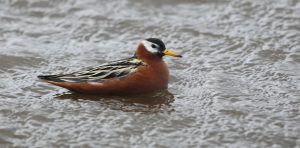
This morning we arrive at Fuglesongen, off the northwest coast of Svalbard, where a couple of Polar Bears are spotted from the bridge. It’s a mother and cub of about two years old, randomly wandering the islands in the hope of finding a few eggs for breakfast, while their last meal could have been weeks ago! A small flotilla of inflatables closes in on the bears as they stalk the coastline within range of the cameras, until the mother decides to take the plunge and swim across the strait to the neighbouring island, well over a mile away, closely followed by her reluctant cub. As the boats never approach swimming bears we leave them to take their chance with the sea crossing and head back to the steep rocky slopes of Fuglesongen, where small flocks of noisy Little Auks fly round in circles before landing on the boulder-strewn slopes, while white-winged Glaucous Gulls look on with sinister intentions. Crossing the strait we relocate the bears on the other island, lazily rolling in patches of snow to cleanse themselves of salt. The mother then returns to the water’s edge to pose on a boulder, just like a Fox’s Glacier Mint bear, as if to say “Let’s go for another swim”, while the cub wails in protest at the thought of another cold soaking. With the iconic Polar Bear ‘in the can’, we return to the ship for lunch, supercharged with success and elation.
This afternoon, we land at Smeerenburg or ‘blubber town’, the site of a seventeenth century Dutch whaling station on Amsterdamøya, where around two hundred men lived and died. All that remains now are remnants of the ovens used to render the whale blubber into oil, although the partially frozen lagoon still harbours plenty of birdlife, including several Glaucous Gulls, a pair of displaying Red-throated Divers, a very handsome drake Long-tailed Duck, plus Turnstone, Sanderling and Knot, all in vibrant breeding plumage, along with a trio of Great Skuas, resting on the frozen lagoon, a couple of passing Pomarine Skuas, with diagnostic spoon-shaped tails, and an Arctic Skua, harrying a Kittiwake for its catch, while being hassled in turn by a posse of Arctic Terns. Meanwhile, half a dozen enormously flabby Walruses laze on the beach, while a couple more roll and frolic in the shallows. What an amazing day in an amazing place.
“Good morning everyone. It’s Thursday 21st June and 1°C outside.”, is the announcement from the bridge at 7.30am. After sailing due west overnight, we are now on the edge of the pack ice, almost half way to Greenland, which is just around 150 miles further west! A mesmerising unearthly seascape of floating ice, in an assortment of random shapes and sizes, like the pieces of a giant chaotic jigsaw puzzle, stretches from the ship’s hull to the misty horizon, as we slowly grind our way through the tightly packed ice floes floating on an inky black sea. As the ship slowly forces its way through the impossible to reassemble ‘jigsaw’ of floating ice, splintering into even more pieces as we steadily inch forward, the gentle movement of the ice floes has a primeval hypnotic effect akin to watching fire. Meanwhile the ship judders and rocks with the sensation of an earthquake and the sound of distant thunder as it brushes past huge ice floes. There are few birds this far from land but we still spot the occasional Fulmar, Kittiwake, Brünnich’s Guillemot and Little Auk, as well as an immaculate brilliant white Ivory Gull. Our goal is to locate the ‘Ice Bear’, and dinner plate-sized footprints on a few of the ice floes are evidence of its recent presence, but the only mammals we find in this brutally inhospitable wilderness are a group of Harp Seals, swimming with the joie de vivre of Dolphins.
With perpetual daylight in the high Arctic summer, one day slips imperceptibly into the next. This morning, the rugged snow-covered Svalbard archipelago is back in view, creating a stunning panorama with a silky smooth sea under a bright blue sky. Nearer to land, the ship is shadowed once again by Kittiwakes, and ‘Northern’ Fulmars, looking very curious as they pass by, virtually at arm’s length. At around 11am, close to Moffen Island, home to Walruses, Glaucous Gulls, Arctic Terns and pale-bellied Brent Geese, the ship crosses the 80° parallel, barely 600 miles from the North Pole, celebrated with rum-flavoured hot chocolate and a group photo to record this momentous ‘milestone’.
“Attention, attention everybody. There’s a Minke Whale on the left side of the ship!”, announces the Expedition Leader over the tannoy, during the lunch time soup course, causing a mad scramble from the dining room to the deck, where the lucky ones catch sight of the whale arching its back clear of the surface alongside the ship! This afternoon, the Zodiacs ferry us ashore on a long shingle beach in Sorgfjorden, where a curious snorting Walrus swims to within three yards of us in clear shallow water! What a remarkable encounter. Further along the same beach, the strong odour of more Walruses wafts towards us on the gentle breeze. We approach to find a dozen or so massive males, ‘hanging out’ as if on a nudist beach! Each is a 1.5 ton mass of flabby blubber, snorting, jostling and fidgeting as if wanting his own space yet too idle to move. Their loose fitting wrinkled skin ripples in waves each time they lollop to get a more comfortable position. Occasionally one sits up briefly and grunts before giving in to gravity and flopping down again. Strolling on across a barren tundra ‘waste’, there is life here, including Purple Sandpipers, a singing male Snow Bunting and even Reindeer, despite the apparent absence of vegetation, barring a sparse density of Purple Saxifrage and Moss Campion. Back on the sun-drenched beach, a few hardy souls go for a swim before heading back to the ship for dinner! With the ship anchored in a sheltered fiord, it’s too beautiful an evening for an early night, and so we stay out on deck in tee shirt weather, ‘soaking up’ the tranquil setting, surrounded by snowy peaks, glaciers, Reindeer somehow grazing on the bare gravelly ground, and a variety of sea birds resting on the still water. Meanwhile, the warm midnight sun is still shining brightly as a new day begins.
The plan was to raise the anchor at 5am, but the winch motor fails to perform, and so plan B involves ‘cutting’ the anchor chain and leaving it behind for a salvage crew, with a loss of about four hours cruising time, but what a lovely place to be marooned. Eventually the ship arrives at the northern end of the Hinlopen Strait between the islands of Spitsbergen to the west and Nordaustlandet to the east, for a Zodiac cruise alongside the spectacular cliffs of Alkefjellet (Auk Mountain). These towering rocky stacks of dolerite make Orkney’s Old Man of Hoy look like a midget! In summer the ledges are choc-full of Brünnich’s Guillemots in their hundreds of thousands, while the air above also swarms with birds, like bees round a hive; a remarkable spectacle. Amidst the crowded ‘seabird city’ we also spot Black Guillemots and marauding Glaucous Gulls, and with so much chattering flapping activity, the sights and sounds create an almost overwhelming experience. Meanwhile, a couple of Arctic Foxes wearing their chocolate brown summer coats and trailing long shaggy white tails, speculatively patrol the well fertilised lower slopes in the hope of finding a hapless nestling. The cliffs end where a massive ice sheet, crumpled by years of pressure, tumbles down to the sea, where an iceberg infused with deep blue ‘lights’ provides a grand finale to an unforgettable time here. Moving on, we sail into Wahlenbergfjorden, yet another magical place, particularly on such a tranquil sunny evening, with extensive ice sheets on both sides. The ship slowly and gently chugs for mile after mile, along the seemingly endless fiord, with countless ice floes dotting the glass calm water. Numerous Bearded and Ringed Seals rest on the distant pack ice, a mother Walrus and pup are hauled out on a small ice floe and another Ivory Gull circles the ship several times, providing lovely photo-opportunities against the blue sky. What a wonderful setting for an evening barbecue on the helicopter deck, followed by dancing and merriment.
“Good morning everyone. It’s Sunday 24th June, and a beautiful morning; 14°C outside.” announces the Bridge over the tannoy before breakfast today. The calm sunny weather is ideal for a landing on Fuglesongen, where it is remarkable to think that we are now walking in the footsteps of the two bears that we watched just a few days earlier! Passing several singing Snow Buntings, today’s target is the colony of Little Auks, which breed among the boulders, strewn across the lower slopes of this island mountain. There is a palpable rush of air from below their short whirring wings, as the birds sweep by in loose flocks, shrieking like Banshees. Between their restless flights, these delightful little birds, with an endearing waddle, adorn the rocks at such close range that one can see the whites of their eyes! Close up they look a dark chocolate colour, rather than black, with a remarkably stubby Bullfinch-like beak. Time passes quickly in the company of such avian delights; another highlight from a memorable expedition.
This afternoon, we enjoy a very peaceful Zodiac cruise in Smeerenburgfjord, where the pointed mountains of Spitsbergen feed glaciers which meet the sea as cliffs of ice over 100 feet high! Compacted over time, this dense ice is riddled with vivid blue ‘veins’. In summer, the milky blue water here is covered with a myriad ‘cubes’ of ice which tinkle as thousands of tiny air bubbles trapped within them burst with a pop. In the quiet Zodiacs, birds resting on the ice, like Black Guillemot, Arctic Tern and Arctic Skua, and a curious Bearded Seal are quite approachable. After dinner, the drinks in the bar are served with ice from the glacier! How cool is that?
It’s Monday morning and we start the new week at 6.15am with a Blue Whale blowing misty spouts high into the air as we sail south towards Alkhornet, a massive pointed cliff towering upwards into the clouds, where the nesting Kittiwakes and Brünnich’s Guillemots are mere specks. Down below, the tundra is grazed by a dozen or so stocky Reindeer, while the ‘usual suspects’ include Barnacle and Pink-footed Geese, Purple Sandpiper, Arctic Skua, Glaucous Gull and several singing Snow Buntings. This afternoon, we board the Zodiacs for the last time, at Ymerbukta, where the huge wall of ice breaks the silence with an occasional explosive blast, as large chunks of ice ‘calve’ from the glacier, causing mini tsunamis as the ice crashes into the water. Another cracking find here is a group of nine majestic King Eider drakes resting alongside ‘Commoners’ on a sandy shore not far from the thundering glacier.
With a free morning after disembarkation, and goodbyes to the fantastic expedition crew, we walk toward the airport, past a Polar Bear warning sign! The campsite on the shore in front of the airport is a brilliant place to chill out amongst the prolific local wildlife here. Purple Sandpipers forage on the ground around one’s feet by the dozen, numerous Barnacle Geese graze the short tundra sward beside the lagoon, where the islands are covered in noisy nesting Arctic Terns. A Red-necked Phalarope, Ringed Plovers and a group of vagrant Teal are all new for the trip list, while other sightings here include Kittiwakes, Glaucous Gulls, a pair of Long-tailed Ducks, several singing Snow Buntings, Eiders, Arctic Skua, another Arctic Fox, and best of all, two stunning drake King Eiders, each with a queen.
Svalbard is definitely ‘out of this world‘, and thanks to a wonderful ship’s crew this has been an incredible ‘trip of a lifetime’, with fantastic memories of Walrus, Bearded Seal, Arctic Fox, Reindeer and Blue Whale, along with some special birds, such as Grey Phalarope, Ivory Gull, King Eider, delightful Little Auks, thousands and thousands of Brünnich’s Guillemots, and of course the Polar Bears, and all in absolutely spectacular scenery.

